The Voltage Standard
February 25, 2016
Having done much
electronic circuit design and
construction in my
career, I have several
multimeters in my home
workshop. The multimeters can be configured as
voltmeters, I have a few
analog voltmeters on my shelves, and my
oscilloscope will also function as a crude analog voltmeter. When wired to a
voltage source, these will read nearly the same value of
voltage, but not the same value. Fortunately, my work doesn't require too
precise values of voltage, so I'm not that concerned.
One of my
digital multimeters will read voltage values to four-and-a-half digits; which, in
electrical engineering parlance, means that it will read from 0 to 1.9999 volts. Seeing such a nice array of digits makes you think that your knowledge of voltage is very good. This reminds me of a
psychology experiment done many
decades ago on how people think that
pocket calculators are
infallible.
A team of
psychologists modified calculators to give the wrong answers. As I remember, nearly all the
test subjects believed that the calculator answers were right, even though a moment's reflection or a
back-of-the-envelope calculation would have indicated that something was amiss. When your
laboratory voltmeter shows many digits, how many of these can you believe?
Although
manufacturers take care to ensure that their
computer chips give the right answers, errors will occur. One famous error was the
Intel Pentium P5 floating point division bug. This was a subtle error, since it would occur in just one in nine billion
divisions. Even then, the error was at the few tens of
parts-per-million level. Intel recalled all the faulty chips at a cost of nearly half a billion
dollars. I recall that in the interim there was a
software patch for the
Excel spreadsheet that corrected this error.
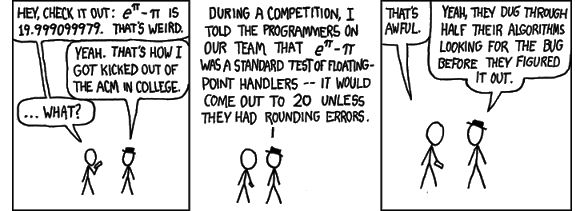
(Webcomic xkcd no. 217 by Randall Munroe, licensed under a Creative Commons Attribution-NonCommercial 2.5 License. Click for original on his xkcd web site.)
Accurate laboratory measurements require
calibration of
instruments to
standards. Most large
corporations have a policy of calibrating their laboratory instruments at intervals. In my laboratory, calibration was done for our
balances and
digital thermometers, but rarely for voltmeters. I had an
antique instrument, a Leeds & Northrup Millivolt Potentiometer, that I used to compare voltage readings against a
standard cell. A standard cell is nothing more than a specially constructed
battery, and a
potentiometer has the unique property of not drawing any
current from the standard cell when it's compared against another voltage source.
The
Weston cell, invented in 1893 by the
chemist,
Edward Weston, was the voltage standard in common use through
1990. The cell
cathode is an
amalgam of
cadmium and
mercury, the cell
anode is pure mercury, and the
electrolyte is an
aqueous solution of
cadmium sulfate. At the anode, cadmium goes into solution as cadmium sulfate. At the cathode,
mercuric sulfate becomes liquid mercury. The
cell potential is 1.018638 volts. More information than you'll ever need about the Weston cell can be found in ref. 1.[1]
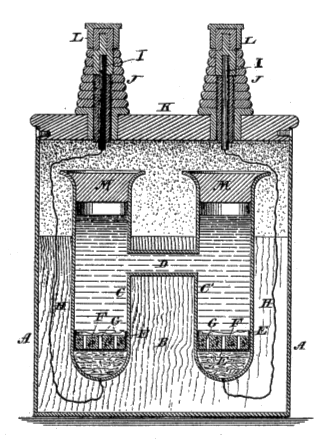
Fig. 1 of US Patent No. 494,827, "Voltaic Cell," by Edward Weston, April 4, 1893.
This cell served as a voltage standard as late as 1990, but it had the disadvantage that it contained the toxic elements, mercury and cadmium.
The voltage of a carefully maintained Weston cell is 1.018638 volts, and the temperature coefficient of the voltage is very small.
(Via Google Patents.)[2])
Semiconductor devices started to replace such
electrochemical voltage reference cells in the
1960s. The first practical semiconductor voltage reference was the
Zener diode, based on a particular
reverse voltage breakdown effect in highly
doped semiconductor
diodes discovered by
Clarence Zener. While
silicon diodes, both Zener and ordinary, have a voltage temperature coefficient of about 2 mV/
°C, you can connect a
reverse-biased Zener diode and a
forward-biased ordinary diode in
series to effectively cancel the temperature effect (see figure). I've done this trick many times in my own circuits.
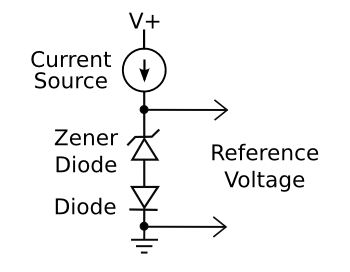
In the days before bandgap voltage reference circuits, analog designers would combine a Zener diode with an ordinary silicon diode to create a temperature-compensated voltage reference.
(Created with Inkscape.)
Other semiconductor voltage references are based on the
bandgap of silicon, which is about 1.22
electronvolts at
absolute zero. The first of these, the
Brokaw bandgap reference, was
invented by
Paul Brokaw in 1974. The Brokaw bandgap reference has a temperature coefficient of just a few tens of ppm/°C.[3] A more recent
bandgap voltage reference is shown in the figure.
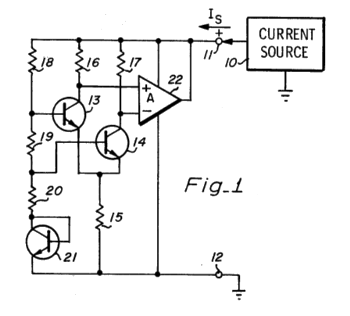
Fig. 1 of US Patent No. 4,447,784, "Temperature compensated bandgap voltage reference circuit" by Robert C. Dobkin.
Dobkin, co-founder of Linear Technology Corporation, has more than a hundred patents.
(Via Google Patents.)[3])
While these simple semiconductor voltage standards are good for most laboratory work, the world demands much more from its
primary standards. That's why a device that operates at
liquid helium temperatures, the
Josephson junction array, is used as today's voltage reference. Such arrays will give a voltage value that's accurate at the
parts per billion level.
The principal behind this device is the
Josephson effect, a property of
superconducting materials separated by a thin
insulating gap discovered by
Brian Josephson. This is a
quantum mechanical effect in which
electrons can
tunnel through the insulator to allow a current flow. If a superconductor-insulator-superconductor junction is driven at a
frequency,
f, then regions of constant voltage will appear in the device
current-voltage curve. These voltages,
Vn are given as

where
h is
Planck's constant, and
e is the
elementary charge. Since the voltages depend only on
fundamental constants, this is a very nice standard. One such voltage standard chip is shown in the photograph. To produce a volt-level signal, the device has many junctions in series, and it's driven at
microwave frequency.
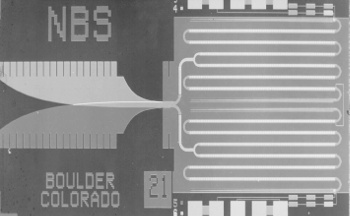
An array of 3020 superconducting Josephson junctions that act as a voltage reference at liquid helium temperature.
(NIST image, via Wikimedia Commons.)
References:
- Walter J. Hamer, "Thermodynamics of Standard Cells of the Saturated Cadmium Sulfate Type," Journal of Research of the National Bureau of Standards A - Physics and Chemistry, vol. 76A, no.3 (May- June, 1972).
- E. Weston, "Voltaic Cell," US Patent No. 494,827, April 4, 1893.
- P. Brokaw, "A simple three-terminal IC bandgap reference," IEEE Journal of Solid-State Circuits, vol. 9, no. 6 (December 1974), pp. 388–393.
- Robert C. Dobkin, "Temperature compensated bandgap voltage reference circuit," US Patent No. 4,447,784, May 8, 1984.
Permanent Link to this article
Linked Keywords: Electronic circuit; design; soldering; construction; career; multimeter; workshop; voltmeter; analog voltmeter; oscilloscope; voltage source; voltage; precise; digital multimeter; electrical engineering; experimental psychology; psychology experiment; decade; pocket calculator; infallible; psychologist; human subject research; test subject; back-of-the-envelope calculation; laboratory; manufacturing; manufacturer; integrated circuit; computer chip; Intel Pentium P5; Pentium FDIV bug; floating point division bug; division; parts-per notation; parts-per-million; dollar; software patch; Excel spreadsheet; Webcomic; xkcd no. 217; Randall Munroe; Creative Commons Attribution-NonCommercial 2.5 License; xkcd; accurate; calibration; laboratory equipment; instrument; metrology standard; corporation; analytical balance; digital thermometer; antique; standard cell; battery; potentiometer; electric current; Weston cell; chemist; Edward Weston; 1990; cathode; amalgam; cadmium; mercury; anode; electrolyte; aqueous solution; cadmium sulfate; mercuric sulfate; electrode potential; cell potential; toxicity; toxic; chemical element; temperature coefficient; Google Patents; semiconductor device; electrochemistry; electrochemical; 1960s; Zener diode; breakdown voltage; reverse voltage breakdown; semiconductor doping; doped; diode; Clarence Zener; silicon; Celsius; °C; biasing; reverse-biased; forward-biased; series circuit; bandgap voltage reference; analog signal; Inkscape; bandgap; electronvolt; absolute zero; Brokaw bandgap reference; invention; invented; Paul Brokaw; bandgap voltage reference; Robert C. Dobkin; Linear Technology Corporation; patent; primary standard; liquid helium; Josephson voltage standard; Josephson junction array; parts per billion; Josephson effect; superconductivity; superconducting; material; electrical insulator; insulating; Brian Josephson; quantum mechanics; quantum mechanical; electron; quantum tunnelling; frequency; current-voltage characteristic; current-voltage curvevPlanck constantvPlanck's constant; elementary charge; physical constant">fundamental constant; microwave; Josephson junction; Wikimedia Commons.